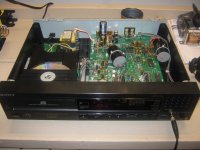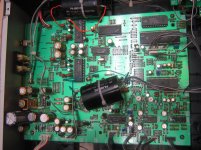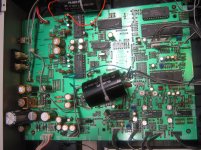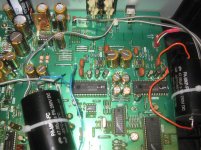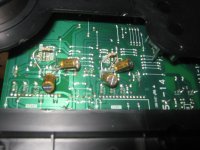I just rebuilt a Sony CDP-508ESD.
Work performed:
1. Complete electrolytic recap with Nichicon Audio Grade Fine Gold series caps;
2. Belt replacement;
3. Deoxit of Volume pot;
4. Replaced all rectifier diodes with Schottkys;
5. Replaced resistors in signal path with metal film;
6. Replaced 47 uF caps in signal path with Solen polypropylene;
7. Removed output caps coupling signal path to ground;
8. Removed muting transistors (no noticeable clicks or booms);
9. Replaced opamps with BB OPA627s on brown dogg adapters;
10. Added 100uF bypass caps to +V and -V on opamps to improve dynamics (see underside photo); and
11. Added 560 Ohm resistors from outputs to -V on opamps to creat 9-10mA biasing current to bias opamps into class A mode (see underside photo).
The player sounds good, but I'm not sure it lived up to my expectations. Does it sound better than my Oppo BD-83? Probably. But it's just different. The Sony probably sounds more analog with tighter bass, but the high end is a tad muted compared to the Oppo, and I think the Oppo has a wider sound stage. I need more listening time with this unit.
Comments?
Work performed:
1. Complete electrolytic recap with Nichicon Audio Grade Fine Gold series caps;
2. Belt replacement;
3. Deoxit of Volume pot;
4. Replaced all rectifier diodes with Schottkys;
5. Replaced resistors in signal path with metal film;
6. Replaced 47 uF caps in signal path with Solen polypropylene;
7. Removed output caps coupling signal path to ground;
8. Removed muting transistors (no noticeable clicks or booms);
9. Replaced opamps with BB OPA627s on brown dogg adapters;
10. Added 100uF bypass caps to +V and -V on opamps to improve dynamics (see underside photo); and
11. Added 560 Ohm resistors from outputs to -V on opamps to creat 9-10mA biasing current to bias opamps into class A mode (see underside photo).
The player sounds good, but I'm not sure it lived up to my expectations. Does it sound better than my Oppo BD-83? Probably. But it's just different. The Sony probably sounds more analog with tighter bass, but the high end is a tad muted compared to the Oppo, and I think the Oppo has a wider sound stage. I need more listening time with this unit.
Comments?
Attachments
Those large caps connected by long wires might negate any benefits and also be prone to stray pickup etc.
See your other thread for thoughts on the opamps
Also try decoupling the opamps rail to rail directly across the supply pins with a small 0.1uf cap rather than large electroylitics coupled into the grounds.
Why not try a FET device such as the OPA604 (dual OPA2604) which I find excellent as an I/V convertor/buffer.
See your other thread for thoughts on the opamps
Also try decoupling the opamps rail to rail directly across the supply pins with a small 0.1uf cap rather than large electroylitics coupled into the grounds.
Why not try a FET device such as the OPA604 (dual OPA2604) which I find excellent as an I/V convertor/buffer.
I definitely agree with Mooly about the big caps. The thing I would consider though is whether you needed a cap that large in value at all.
Assuming the downstream device has an input impedance of 10kR, the cutoff frequency of the high pass filter that big cap forms is 0.34 Hz. A 4.7uF cap would give a cutoff frequency of 3.38 Hz, which is far enough away from 20 Hz to be fine.
I'd swap that huge cap out for something more reasonable, either 10 or 4.7 uF. You should be able to mount one of them right on the board with very short leads.
Assuming the downstream device has an input impedance of 10kR, the cutoff frequency of the high pass filter that big cap forms is 0.34 Hz. A 4.7uF cap would give a cutoff frequency of 3.38 Hz, which is far enough away from 20 Hz to be fine.
I'd swap that huge cap out for something more reasonable, either 10 or 4.7 uF. You should be able to mount one of them right on the board with very short leads.
Interesting. The original caps were 47uF, which is why I chose those.
I've now run the leads from the CAPS directly to two new outputs I installed on the rear of the unit, which has further improved the sound.
So, you guys think smaller caps abd shorter leads would help more?
I've now run the leads from the CAPS directly to two new outputs I installed on the rear of the unit, which has further improved the sound.
So, you guys think smaller caps abd shorter leads would help more?
Yeah, electrolytic output cap are almost always much larger than they need to be. I guess it because they are cheap and small, and it may make up for their other deficiencies somewhat.
If you run the cap directly to the output, and there aren't any long leads, it should be okay. You've bought and fitted the 47uFs, I wouldn't go back and change them now.
If you run the cap directly to the output, and there aren't any long leads, it should be okay. You've bought and fitted the 47uFs, I wouldn't go back and change them now.
I must correct the original message: this CDP sounds great and clearly beats the OPPO BD-83.
I had originally hooked my amp up via the variable output of the Sony, which has the sound running through a long cable that goes to the front of the unit, through a pot, and then back to the rear.
After trying the fixed output, the sound improved noticeably. I then installed new outputs connected directly to the solens, and DAMN.
Mighty fine sound. I've very pleased with this unit now.
I had originally hooked my amp up via the variable output of the Sony, which has the sound running through a long cable that goes to the front of the unit, through a pot, and then back to the rear.
After trying the fixed output, the sound improved noticeably. I then installed new outputs connected directly to the solens, and DAMN.
Mighty fine sound. I've very pleased with this unit now.
The 47uf output caps are TOTALLY unnecessary. You can simply delete them & replace with jumper wires. Also, the major difference between this & the 608ESD is that the output stages & dac run on +/-5V, rather than +/-12V. I don't believe the OPA627 can run near it's best at such low voltage, but I have had great results running OPA2134's in this model, but with at least 470uf Nichicon & 0.47uf PP film directly from each chip's supply pins to ground. I've long considered the PCM58 to be the best sounding 18bit dac on the planet, so I would have been really shocked if you said the Oppo sounded better.
BTW, DuPont Triflow is HUGELY better & vastly longer life than DeOxit, ProGold or any other Caig product.
BTW, DuPont Triflow is HUGELY better & vastly longer life than DeOxit, ProGold or any other Caig product.
The 47uf output caps are TOTALLY unnecessary. You can simply delete them & replace with jumper wires. Also, the major difference between this & the 608ESD is that the output stages & dac run on +/-5V, rather than +/-12V. I don't believe the OPA627 can run near it's best at such low voltage, but I have had great results running OPA2134's in this model, but with at least 470uf Nichicon & 0.47uf PP film directly from each chip's supply pins to ground. I've long considered the PCM58 to be the best sounding 18bit dac on the planet, so I would have been really shocked if you said the Oppo sounded better.
BTW, DuPont Triflow is HUGELY better & vastly longer life than DeOxit, ProGold or any other Caig product.
Stephenshank, this is interesting information.
BTW, I measured the DC output from the OPA627s to be ~ 80mV. Isn't sending this directly to my amp somewhat dangerous?
Those are big caps you're putting on the OPA2134. Why so large? I already paused when putting the 100uFs in based on a recommendation on this site.
Do you know if it's possible to simply change the power supply to the opamps and leave everything else in the circuit untouched? I actually have a transformer and power supply circuirt that supplies +/- 12VDC that I could coupled to the +/-V pins of the sockets for the OPA 627s.
One reason I biased the OPA627 into class A at 10mV was because of the low supply voltage, wondering (intuitively) if this would compensate for it...
That 80mV offset a)is likely to disappear once the stage has a direct-coupled load, and b)is insignificantly small, even directly connected to a dc-coupled power amp. So, no worries.
I thought about adding a +/-12V supply to the last 508esd I upgraded, and it is quite possible, but it gets a bit complicated by the shared lines to the dac, some of which need to remain at 5V. I do think it would give a worthwile improvement, but wasn't economical in my case. That added supply does, of course, need to be very high quality & super clean.
I have found by a very, very large amount of experimentation that you really do need a LOT of stored energy(large lytics) instantaneously available to even line level gain stages in order to get the best transient response & transmission line-drive. With Burr-Brown & other nice opamp chips, I have found irrefutable benefit going from 220uf to 470uf directly at each supply pin, which I wasn't actually expecting the first time I tried it. The 470uf(with generous film cap bypassing) really brought the bass into 'full reality' and gave the whole picture much more depth of tone. When I have the room, I routinely go as high as 2200uf on 2134 supply pins.
Incidentally, I personally find the OPA627 to be positively colored. I would only use them if I had a harsh sounding dac that needed a 'bandaid'. Even then, I would only have ONE maximum in each channel. Two OPA627's in a channel will really show you just how unnaturally colored they are. To my ears, one 627 = light cream sauce, and two 627's in series = molasses. The OPA134/2134/4134 is my personal favorite as it, when properly power-supplied, gives tremendous tonal richness that is natural. I've experimentally put four stages of 134 in series, and still had the same beautiful tone, whereas four 627's in series would be thicker syrup than a stock Dynaco PAS2. Oh, and the 2134 would not at all need the bias bootstrap you added for the 627, even if you stay with 5V lines.
I thought about adding a +/-12V supply to the last 508esd I upgraded, and it is quite possible, but it gets a bit complicated by the shared lines to the dac, some of which need to remain at 5V. I do think it would give a worthwile improvement, but wasn't economical in my case. That added supply does, of course, need to be very high quality & super clean.
I have found by a very, very large amount of experimentation that you really do need a LOT of stored energy(large lytics) instantaneously available to even line level gain stages in order to get the best transient response & transmission line-drive. With Burr-Brown & other nice opamp chips, I have found irrefutable benefit going from 220uf to 470uf directly at each supply pin, which I wasn't actually expecting the first time I tried it. The 470uf(with generous film cap bypassing) really brought the bass into 'full reality' and gave the whole picture much more depth of tone. When I have the room, I routinely go as high as 2200uf on 2134 supply pins.
Incidentally, I personally find the OPA627 to be positively colored. I would only use them if I had a harsh sounding dac that needed a 'bandaid'. Even then, I would only have ONE maximum in each channel. Two OPA627's in a channel will really show you just how unnaturally colored they are. To my ears, one 627 = light cream sauce, and two 627's in series = molasses. The OPA134/2134/4134 is my personal favorite as it, when properly power-supplied, gives tremendous tonal richness that is natural. I've experimentally put four stages of 134 in series, and still had the same beautiful tone, whereas four 627's in series would be thicker syrup than a stock Dynaco PAS2. Oh, and the 2134 would not at all need the bias bootstrap you added for the 627, even if you stay with 5V lines.
Thanks, Stephenshank.
I'm just loving the way this player sounds as it breaks it. I'm hearing treble in jazz with clarity I've never heard outside of a concert hall before.
I'm considering trying higher voltage on the opamp, but as you say, it's an undertaking considering I'd need to cut the traces leading away from the opamp. Maybe I'll try bigger caps first and see how that works.
I'm just loving the way this player sounds as it breaks it. I'm hearing treble in jazz with clarity I've never heard outside of a concert hall before.
I'm considering trying higher voltage on the opamp, but as you say, it's an undertaking considering I'd need to cut the traces leading away from the opamp. Maybe I'll try bigger caps first and see how that works.
- Status
- This old topic is closed. If you want to reopen this topic, contact a moderator using the "Report Post" button.
- Home
- Source & Line
- Digital Source
- Modded Sony CDP-508ESD
